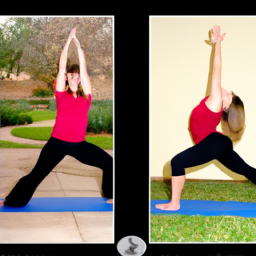In this article, you will learn how you can incorporate yoga into your regular workout routine to increase your strength. Yoga is not just about flexibility and relaxation, it can also be a great way to build muscle and improve your overall fitness. By combining yoga poses with your usual weightlifting or cardio exercises, you can reap the benefits of both worlds and enhance your physical performance.
To begin incorporating yoga into your regular workout routine, start by choosing a few yoga poses that focus on strength-building. Poses like Downward Dog, Plank, and Warrior II are excellent options to start with. Before or after your usual workout, take a few minutes to perform these poses and hold them for a few breaths to engage your muscles. As you become more comfortable, you can gradually include more challenging poses into your routine. The key is to listen to your body and find a balance that works for you. With consistency and practice, you will notice improvements in your strength and flexibility, enhancing your overall fitness level.
Benefits of Yoga for Strength
Yoga is often associated with relaxation, flexibility, and mindfulness. However, it is also an effective workout for building strength. Incorporating yoga into your regular workout routine can bring a myriad of benefits, including improved muscular strength, increased flexibility and range of motion, and enhanced balance and stability.
Improves muscular strength
One of the key benefits of practicing yoga for strength is its ability to improve muscular strength. While yoga may not include heavy weightlifting or intense resistance training, it challenges your muscles in a different way. Many yoga poses require you to hold your body weight, which helps to build strength and endurance in your muscles.
Poses such as Downward Dog, Warrior II, and Crow Pose engage multiple muscle groups, including your arms, shoulders, core, and legs. By practicing yoga regularly, you can gradually increase your muscle strength and tone.
Increases flexibility and range of motion
In addition to building strength, yoga also greatly improves flexibility and range of motion. Many yoga poses involve deep stretching, which helps to lengthen and loosen tight muscles. This increased flexibility not only allows you to perform yoga poses more easily, but it also benefits your overall physical health.
Flexibility is important for maintaining good posture, reducing muscle tension, and preventing injuries. By incorporating yoga into your workout routine, you can improve your flexibility and enhance your overall range of motion.
Enhances balance and stability
Balance and stability are vital components of physical fitness. Yoga poses often require you to maintain a steady balance while engaging various muscle groups. This helps to strengthen the muscles that support your body’s balance and stability.
Poses like Tree Pose, Warrior III, and Eagle Pose challenge your ability to stay centered and balanced. By practicing these poses regularly, you can improve your balance and stability, which translates to better overall coordination and reduced risk of falls or injuries.
Different Types of Yoga for Strength
There are various types of yoga that focus on increasing strength. Here are a few popular styles:
Power Yoga
Power Yoga is a vigorous and dynamic form of yoga that combines strength-building poses with continuous movement. It is often practiced in a heated room to increase the intensity and challenge. Power Yoga challenges your muscles and cardiovascular system, making it a great option for those looking to build strength and improve endurance.
Ashtanga Yoga
Ashtanga Yoga is a traditional form of yoga that follows a specific sequence of poses. It is known for its rigorous and physically demanding nature, making it ideal for those seeking to build strength. Ashtanga Yoga emphasizes flowing movements and deep stretching, which help to strengthen muscles and increase flexibility.
Iyengar Yoga
Iyengar Yoga focuses on proper alignment and precise movements. It utilizes props such as blocks, straps, and blankets to assist in achieving correct alignment. By holding poses for longer periods and paying attention to alignment, Iyengar Yoga helps to build strength and improve body awareness.
Yoga Poses for Building Strength
Incorporating specific yoga poses into your regular workout routine can further enhance your strength-building efforts. Here are a few poses that can help you build strength:
Warrior I and II
The Warrior poses are excellent for building lower body strength, particularly in the legs and hips. Warrior I and II poses not only strengthen your quadriceps and glutes but also engage your core and upper body muscles. These poses also help to improve balance and stability.
To practice Warrior I, start by stepping your right foot forward and bending your right knee. Reach your arms overhead and gaze forward. To practice Warrior II, spread your feet wide apart, point your right foot forward, and bend your right knee while extending your arms out to the sides.
Plank Pose
Plank Pose is a full-body strengthener that primarily targets your core muscles. It also engages your arms, shoulders, and leg muscles. To practice Plank Pose, start in a push-up position with your hands directly beneath your shoulders, and your body in a straight line. Engage your core, and hold the pose for several breaths.
Boat Pose
Boat Pose is a challenging pose that targets your core, hip flexors, and leg muscles. It also improves balance and stability. To practice Boat Pose, sit on the floor with your knees bent and your feet flat on the ground. Lean back slightly and lift your feet off the ground, balancing on your sitting bones. Extend your arms forward, parallel to the ground. Hold the pose for a few breaths.
Incorporating Yoga into Weightlifting Routine
Yoga can be a valuable addition to your weightlifting routine as it helps to improve flexibility, prevent injuries, and promote overall balance and well-being. Here are some ways to incorporate yoga into your weightlifting routine:
Pre-workout yoga warm-up
Before starting your weightlifting session, take a few minutes to warm up your muscles with some yoga poses. Choose poses that target the muscle groups you will be working on during your weightlifting session. This will help to activate those muscles, improve mobility, and prevent injuries.
A few yoga poses you can include in your warm-up routine are Cat-Cow, Downward Dog, and Sun Salutations. These poses help to stretch and mobilize your spine, shoulders, hips, and legs, preparing your body for the weightlifting workout.
Yoga as a post-workout stretch
After your weightlifting session, include a yoga cool-down/stretching routine to help your muscles recover and reduce post-workout soreness. Holding gentle yoga poses can relieve tension in the muscles, improve circulation, and promote relaxation.
Choose poses that target the muscle groups you just worked on during your weightlifting session. Deep lunges, Pigeon Pose, and Sphinx Pose are great options for stretching the hips and lower back. Child’s Pose and Seated Forward Bend can help stretch your hamstrings and relieve tension in your shoulders and neck.
Combining weightlifting and yoga
Another way to incorporate yoga into your weightlifting routine is to alternate weightlifting days with yoga practice. This allows you to focus on building strength on your weightlifting days and enhancing flexibility and balance on your yoga days.
By combining weightlifting and yoga, you can create a well-rounded fitness routine that targets both strength and flexibility. This synergistic approach can help to improve overall athletic performance and prevent overuse injuries.
Incorporating Yoga into Cardiovascular Exercise Routine
Yoga can also be beneficial when incorporated into your cardiovascular exercise routine. Here are some ways to integrate yoga into your cardio workouts:
Yoga for recovery
After an intense cardio session, incorporating yoga can help your body recover more effectively. Yoga poses focusing on stretching and relaxation can aid in easing muscle soreness and promoting faster recovery.
Choose gentle poses like Child’s Pose, Legs-Up-The-Wall, and Supine Twist to help release tension and restore your body’s balance after a cardio workout. These poses can help you relax, improve circulation, and promote better sleep.
Yoga for cross-training
Yoga can be an excellent form of cross-training for cardio enthusiasts. While cardio workouts primarily focus on cardiovascular fitness, yoga complements them by providing strength, flexibility, and balance training. Additionally, yoga practice can help prevent imbalances and injuries commonly associated with repetitive cardio movements.
Incorporate yoga sessions into your weekly cardio routine to add variety and balance. This will help you to engage different muscle groups, improve your overall athletic performance, and reduce the risk of overuse injuries.
Yoga for active rest days
On days when your body needs a break from high-intensity cardio workouts, gentle yoga practice can be a great option for active rest. Active rest refers to engaging in light physical activity that promotes recovery without causing additional stress on the body.
Choose restorative or gentle flow yoga sequences on your active rest days. These sequences focus on stretching, relaxation, and breathing exercises, helping to promote recovery and rejuvenation while maintaining an active lifestyle.
Yoga for Injury Prevention and Rehabilitation
Beyond building strength and enhancing performance, yoga is also beneficial for injury prevention and rehabilitation. Here’s how yoga can help:
Improving joint stability
Many yoga poses require proper alignment and engagement of the joints, helping to improve joint stability. Strengthening the muscles around the joints through yoga practice can reduce the risk of injury and provide support for joints that may be prone to instability.
Strengthening supporting muscles
Yoga helps strengthen the supporting muscles that are often neglected in traditional workouts. These smaller, stabilizing muscles are crucial for maintaining proper posture and alignment, reducing the risk of overcompensation and injury.
Practicing yoga poses like Tree Pose, Bridge Pose, and Chair Pose can help strengthen the muscles in your feet, ankles, knees, and hips, providing a solid foundation for overall strength and stability.
Enhancing body awareness
Yoga promotes body awareness, which is key to injury prevention. By practicing yoga, you become more attuned to your body’s signals, allowing you to recognize and address imbalances or weaknesses before they lead to more serious injuries.
Through mindful movement and breath, yoga encourages you to listen to your body and adjust your practice accordingly. This increased body awareness can help you identify and correct imbalances or compensate for weaknesses, reducing the risk of injury during other physical activities.
How Often Should Yoga Be Incorporated into Workout Routine
The frequency of incorporating yoga into your workout routine depends on your fitness level and goals. Here are some general guidelines for different levels of yoga practitioners:
Frequency for beginners
If you’re new to yoga, it’s recommended to start with two to three yoga sessions per week. This allows your body to adapt to the practice and gradually build strength and flexibility. Beginners may find it beneficial to attend guided yoga classes or follow online tutorials to ensure proper form and alignment.
Frequency for intermediate practitioners
For those who have been practicing yoga regularly and have developed a certain level of strength and flexibility, aim for at least three to four yoga sessions per week. This frequency allows for continued progress in your practice and helps to maintain and further enhance your strength and flexibility.
Intermediate practitioners can also start exploring more challenging yoga styles and poses to continue advancing their practice.
Frequency for advanced yogis
As an advanced yogi, you may choose to practice yoga on a daily basis. Daily yoga practice allows for deeper exploration and refinement of yoga poses and sequences. Advanced practitioners may also incorporate longer yoga sessions or intensify their practice with advanced poses or more vigorous yoga styles.
However, it’s important to listen to your body and give yourself enough rest and recovery time to avoid overtraining or burnout.
Tips for Effective Yoga Integration
To make the most out of incorporating yoga into your workout routine, keep the following tips in mind:
Setting specific goals
Identify your specific goals for incorporating yoga into your workout routine. Whether it’s building strength, increasing flexibility, or enhancing overall well-being, having clear goals will help you choose the most suitable yoga styles and poses for your needs.
Listening to your body
Pay attention to how your body feels during and after yoga practice. If a pose feels uncomfortable or painful, modify or skip it. Yoga should challenge you, but it should never cause pain or lead to injury. Always honor your body’s limits and adjust your practice accordingly.
Seeking guidance from a qualified instructor
If you’re new to yoga or unsure about proper form and alignment, consider seeking guidance from a qualified yoga instructor. They can help you learn the correct techniques, provide individualized modifications, and ensure that your yoga practice is safe and effective.
Attending regular yoga classes or scheduling private sessions with an instructor can also help you stay motivated and accountable in your yoga journey.
Common Mistakes to Avoid
When incorporating yoga into your workout routine, it’s important to avoid these common mistakes:
Pushing too hard
Yoga is a practice of balance and moderation. Avoid pushing yourself too hard or striving for perfection. Instead, focus on listening to your body, practicing with mindfulness, and gradually building strength and flexibility at a pace that feels comfortable for you.
Neglecting proper form
Proper form and alignment are crucial in yoga to avoid injuries and maximize the benefits of each pose. Take the time to understand and practice the correct alignment for each pose. If you’re unsure, seek guidance from a qualified yoga instructor.
Skipping warm-up and cool-down
Just like any other workout, it’s important to warm up your muscles before diving into your yoga practice. A proper warm-up can help prevent injuries and improve your overall performance. Similarly, taking the time to cool down and stretch after your yoga session can aid in recovery and reduce post-workout soreness.
Conclusion
Incorporating yoga into your regular workout routine can bring a myriad of benefits to enhance strength, flexibility, balance, and injury prevention. By choosing the right style of yoga and integrating it strategically into your regular workouts, you can enjoy a well-rounded fitness regimen that nourishes both body and mind.
So, whether you’re a weightlifter looking to improve flexibility and prevent injuries, a cardio enthusiast seeking to add strength training to your routine, or someone looking to enhance overall physical and mental well-being, including yoga in your workout routine can be a game-changer. Start by setting your goals, listening to your body, and seeking guidance from a qualified instructor. Get ready to experience the transformative power of yoga and reap the benefits in every aspect of your life.





